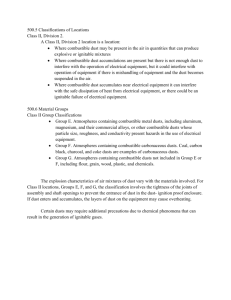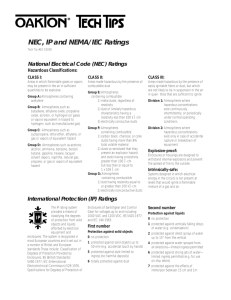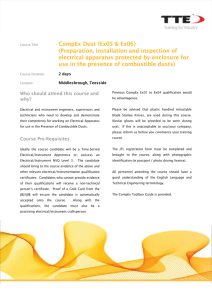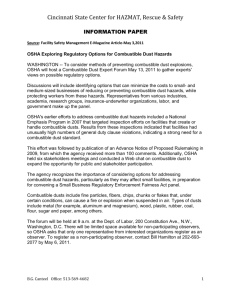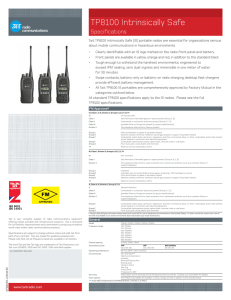HSCXT SERIES
advertisement
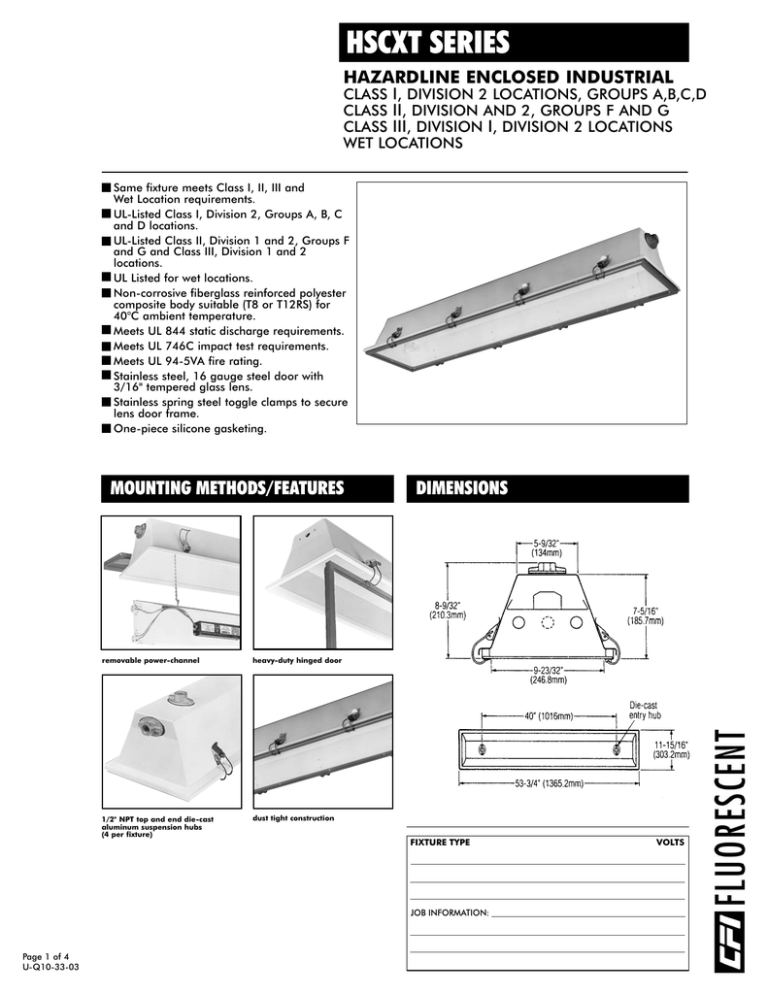
HSCXT SERIES HAZARDLINE ENCLOSED INDUSTRIAL CLASS I, DIVISION 2 LOCATIONS, GROUPS A,B,C,D CLASS II, DIVISION AND 2, GROUPS F AND G CLASS III, DIVISION I, DIVISION 2 LOCATIONS WET LOCATIONS Same fixture meets Class I, II, III and Wet Location requirements. UL-Listed Class I, Division 2, Groups A, B, C and D locations. UL-Listed Class II, Division 1 and 2, Groups F and G and Class III, Division 1 and 2 locations. UL Listed for wet locations. Non-corrosive fiberglass reinforced polyester composite body suitable (T8 or T12RS) for 40°C ambient temperature. Meets UL 844 static discharge requirements. Meets UL 746C impact test requirements. Meets UL 94-5VA fire rating. Stainless steel, 16 gauge steel door with 3/16" tempered glass lens. Stainless spring steel toggle clamps to secure lens door frame. One-piece silicone gasketing. MOUNTING METHODS/FEATURES removable power-channel heavy-duty hinged door 1/2" NPT top and end die-cast aluminum suspension hubs (4 per fixture) dust tight construction DIMENSIONS FIXTURE TYPE JOB INFORMATION: Page 1 of 4 U-Q10-33-03 VOLTS HSCXT SERIES HAZARDLINE ENCLOSED INDUSTRIAL ENCLOSED INDUSTRIAL FLUORESCENT PHOTOMETRY MODEL NO. HSCXT232 CLASS I, DIVISION 2 LOCATIONS Typical Class I Locations: • Petroleum refineries, and gasoline storage and dispensing areas. • Industrial firms that use flammable liquids in dip tanks for parts cleaning or other operations. • Petrochemical companies that manufacture chemicals from gas and oil. • Dry cleaning plants where vapors from cleaning fluids can be present. A Class I, Division 2 location is a location: (1) in which volatile flammable liquids or flammable gases are handled, processed, or used, but in which the liquids, vapors, or gases will normally be confined within closed containers or closed systems from which they can escape only in case of accidental rupture or breakdown of such containers or systems, or in case of abnormal operation of equipment, or (2) in which concentrations of ignitible gases or vapors are normally prevented by positive mechanical ventilation, but which might become hazardous through failure or abnormal operation of the ventilating equipment; or (3) that is adjacent to a Class I, Division 1 location, and to which concentrations of ignitible gases or vapors might occasionally be communicated unless such communication is prevented by adequate positivepressure ventilation from a source of clean air, and effective safeguards against ventilation failure are provided. This classification usually includes locations where volatile flammable liquids or flammable gases or vapors are used, but which, in the judgment of the authority having jurisdiction, would become hazardous only in case of an accident or of some unusual operating condition, The quantity of hazardous material that might escape in case of accident, the adequacy of ventilating equipment, the total area involved, and the record of the industry or business with respect to explosions or fires are all factors that merit consideration in determining the classification and extent of each location. Piping without valves, checks, meters, and similar devices would not ordinarily introduce a hazardous condition even though used for flammable liquids or gases. Locations used for the storage of flammable liquids or of liquefied or compressed gases in sealed containers would not normally be considered hazardous unless subject to other hazardous conditions also. Electrical conduits and their associated enclosures separated from process fluids by a single seal or barrier shall be classed as a Division 2 location if the outside of the conduit and enclosures is an unclassified location. • Companies that have spraying areas where they coat products with liquid paint or plastics. • Aircraft hangers and fuel servicing areas. • Utility gas plants and operations involving storage and handling of liquefied petroleum gas or natural gas. TYPICAL CLASS III LOCATIONS • Textile mills, cotton gins, cotton seed mills and flax processing plants. • Any plant that shapes, pulverizes or cuts wood and creates sawdust or flyings. TYPICAL CLASS II LOCATIONS • Grain elevators, flour and feed mills. • Plants that have chemical or metallurgical processes...producers of plastics, medicines and fireworks, etc. • Producers of starch or candies. • Spice-grinding plants, sugar plants and cocoa plants. • Coal preparation plants and other carbon-handling or processing areas. Page 2 of 4 U-Q10-33-03 Note: fibers and flyings are not likely to be suspended in the air, but can collect around machinery or on lighting fixtures and where heat, a spark or hot metal can ignite them. HSCXT SERIES HAZARDLINE ENCLOSED INDUSTRIAL ENCLOSED INDUSTRIAL FLUORESCENT IGNITIBLE DUST LOCATIONS The following hazardous location definitions pertinent to HAZARDLINE are excerpted from Article 500 of the 1990 National Electrical Code. Class II Locations Class II locations are those that are hazardous because of the presence of combustible dust. Class II locations shall include those specified in (a) and (b) below. (a) Class II, Division 1 A Class II, Division 1 location is a location; (1) in which combustible dust is in the air under normal operating conditions, in quantities sufficient to produce explosive or ignitible mixtures; or (2) where mechanical failure or abnormal operation of machinery or equipment might cause such explosive or ignitible mixtures to be produced, and might also provide a source of ignition through simultaneous failure of electrical equipment, operation of protection devices, or from other causes; or (3) in which combustible dusts of an electrically conductive nature may be present in hazardous quantities. Combustible dusts which are electrically nonconductive include dusts produced in the handling and processing of grain and grain products, pulverized sugar and cocoa, dried egg and milk powders, pulverized spices, starch and pastes, potato and woodflour, oil meal from beans and seed, dried hay, and other organic materials which may produce combustible dusts when processed or handled. Electrically conductive dusts are dusts with a resistivity less than 105 ohm-centimeter. (b) Class II, Division 2 A Class II, Division 2 location is a location where combustible dust is not normally in the air in quantities sufficient to produce explosive or ignitible mixtures, and dust accumulations are normally insufficient to interfere with the normal operation of electrical equipment or other apparatus, but combustible dust may be in suspension in the air as a result of infrequent malfunctioning of handling or processing equipment and where combustible dust accumulations on, in, or in the vicinity of the electrical equipment may be sufficient to interfere with the safe dissipation of heat from electrical equipment or may be ignitible by abnormal operation or failure of electrical equipment. The quantity of combustible dust that may be present and the adequacy of dust removal systems are factors that merit consideration in determining the classification and may result in an unclassified area. Where products such as seed are handled in a manner which produces low quantities of dust, the amount of dust deposited may not warrant classification. Page 3 of 4 U-Q10-33-03 Group F Atmospheres: Atmospheres containing carbon black, charcoal, coal or coke dusts which have more than 8 percent total volatile material (coal and coke dusts per ADTM 317582) or atmospheres containing these dusts sensitized by other materials so that they present an explosion hazard, and having resistivity greater than 102 ohmcentimeter but equal to or less than 108 ohm-centimeter. Group G Atmospheres: Atmospheres containing combustible dusts having resistivity of 108 ohm-centimeter or greater. Class III Locations Class III locations are those that are hazardous because of the presence of easily ignitible fibers of flyings, but in which such fibers or flyings are not likely to be in suspension in the air in quantities sufficient to produce ignitible mixtures. Class III locations shall include those specified in (a) and (b) below. (a) Class III, Division 1 A Class III, Division 1 location is a location in which easily ignitible fibers or materials producing combustible flyings are handled, manufactured, or used. Such locations usually include some parts of rayon, cotton, and other textile mills; combustible fiber manufacturing and processing plants; cotton gins and cotton-seed mills; flax-processing plants, clothing manufacturing plants; woodworking plants; and establishments and industries involving similar hazardous processes or conditions. Easily ignitible fibers and flyings include rayon, cotton (including cotton linters and cotton waste), sisal or henequen, istle, jute, hemp, tow, cocoa fiber, oakum, baled waste kapok, Spanish moss, excelsior and other materials of similar nature. (b) Class III, Division 2 A Class III, Division 2 location is a location in which easily ignitible fibers are stored or handled. Exception: In process of Manufacture. CAUTION: HAZARDLINE is not UL-listed for Group E: Atmospheres containing combustible metal dusts regardless of resistivity, or other combustible dusts of similarly hazardous characteristics having resistivity of less than 102 ohm-centimeter. CAUTION: HAZARDLINE Class I, Division 2 is not listed for Division 1 applications where the hazardous atmosphere is expected to be present continuously or periodically during normal operations or frequently because of repair or maintenance operations. For such locations, only appropriate UL-listed explosion-proof equipment is permitted. HAZARDLINE ENCLOSED INDUSTRIAL HSCXT SERIES ENCLOSED INDUSTRIAL FLUORESCENT ORDERING INFORMATION Explanation of Catalogue Number Example: HSGXT232120SO HSC XT 2 32 120 SO HAZARDLINE: Class I, Division 2 Class II, III NUMBER OF LAMPS IN WIDTH: 2 or 3 Lamps LAMP/FIXTURE LENGTH: 32=T8 4' 34=T12 4' 48 HO=T8 or T12 HO VOLTAGE: 120, 277, 347 BALLAST TYPE: LE= 1 & 2 lamp Mag. T12 SO= 1 & 2 lamp Elec. T8 O3= 1 - 3 lamp Elec. T8 BLANK= T12 HO Enclosed Industrial Fluorescent (No 3 lamp 48 HO) OPTIONS: Add appropriate suffix to catalog no. OPTIONS/ACCESSORIES COLD WEATHER BALLASTS: HO fixtures are standard with -20°F ballasts. To specify cold-weather (O°F) ballasts for RS fixtures, SUFFIX: CW (T12), 5C (T8). 45° ADJUSTABLE STAINLESS STEEL QUADRANT BRACKETS: Two sturdy “L” type adjusta-mounts with gaskets for field installation at top and side ends of fixture. Permit housing to be permanently surfacemounted and adjusted up to 45° in either direction in 5° increments. Provide wide-spread directed illumination where tasks are not fixed. Specify Bracket Catalog Number: NKH45. THERMAL PERFORMANCE OF HSCXT FIXTURES* Catalog Number Lamps Quantity Type Ambient Temp. °C “T” Numbers Fixture Temperature* HSCXT132 2 T8 40 T-4A 120°C (248°F) HSCXT332 3 T8 40 T-4A 120°C (248°F) SPECIFICATIONS: MATERIALS: Chassis is non-corrosive one-piece seamless molded fiberglass reinforced polyester composite body suitable (T8 or T12 RS) for 40°C ambient temperatures, with 1/2" NPT (2 on top of body and 1 at each end of body, fully gasketed and fastened to body with two 1/4-20 machine screws and lockwashers within the fixture body. WIREWAY: Full-length rigidly formed wireway cover with all electrical components retained to body with captive screws for easy removal and can be suspended with safety-chains for convenient handling and service. FINISH: Body–white polyester composite with 85% minimum reflectivity. Power Channel/Reflector–phosphate primed, baked white acrylic enamel with minimum 86% reflectivity. LENS FRAME: Stainless steel, non-corrosive 16-gauge steel frame gasketed with silicone, securely attached to frame. Hinges both sides. LENS: 3/16" thick tempered glass. LENS FRAME CLAMPS: Stainless spring steel toggle clamps. ELECTRICAL: Thermally protected class “P” ballast C.B.M. approved, non PCB. If K.O. is within 3" of ballast, use wire suitable for at least 90°. LABELS: I.B.E.W./UL and C-UL. We reserve the right to change, materials and finish in any way that will not alter installed appearance or reduce function and performance. 525 EDUCATION RD., CORNWALL, ONTARIO K6H 6C7 TEL.: (613) 938-6221 FAX: (613) 938-0961 Page 4 of 4 U-Q10-33-03
